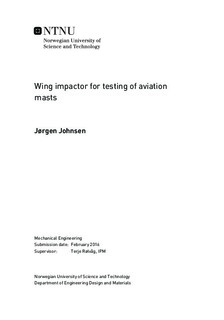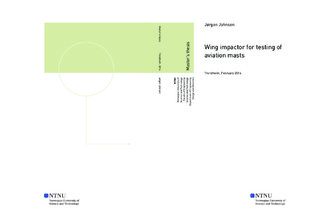| dc.description.abstract | Operations at airfields require the use of certain visual and nonvisual aids in order to operate at nearly any weather condition. Some of these, such as the approach lighting system are positioned in such a way as to present a hazard to aircraft safety. The support structure of the approach lighting system are required to be frangible. The frangibility of a mast determines through a full-scale dynamical crash-test, where the masts deformation sequence, max impact force and energy are direct measures on its frangibility. Today s standard recommends the use of a rigid impactor to represent the wing section of a small aircraft. Simulations show however that the rigid impactor generates initial reaction forces far above the ICAO rules. The rigid impactor is still used due low production and test cost related to it. The current version of a deformable impactor is a true copy of the wing section of a small aircraft. This makes it complex and expensive to manufacture. The main objective of this thesis is therefore to develop an alternative low-cost deformable impactor for future crash-tests.
Through studying test results from previous quasi-static compression tests of the current standard wing impactor, I define and describe a characteristic dynamic force-response in which the new impactor must mimic. Several concepts has been evaluated, where a simplification of the current soft wing impactor showed to provide the best solution with respect to both dynamic response and cost. A detailed version of the concept has been proposed.
To test the chosen products dynamical responses, a quasi-statical compression test and a dynamical compression test has been performed in ABAQUS. The impactor was compressed using a rigid intruder with a representative cross-section of a typical aviation mast. The quasi-static compression test was performed with an intruder speed of 50 mm/min and the dynamical with an intruder speed of 140 km/h. A bi-linear material model and a non-linear material model was chosen to investigate the effects of strain hardening on the post-yielding behavior.
The results from the quasi-static compression tests showed promising results with regards to deformation modes, but the strength of the impactor was a little low. This could be increased by small alteration of geometry. The model showed to be sensitive to strain hardening, which had a negative effect and altered deformation modes slightly. The dynamical compression test showed to be in very good relation to the current soft wing impactor, both in deformation modes and recorded force levels. The model was not sensitive to strain hardening in the dynamical analysis. These results must however be considered only as an indication on the impactors properties, as a there are great uncertainties related to the material modelling used. Optimization of the concept and further testing and validation is necessary before this product can be put to use. | |

